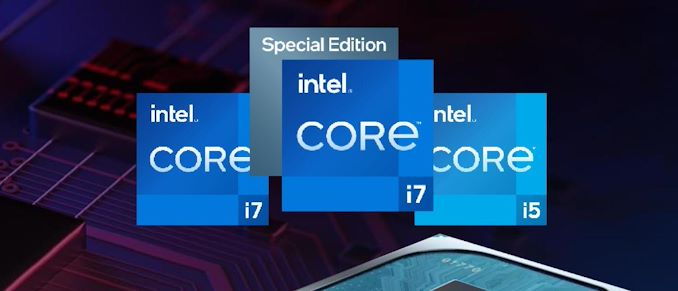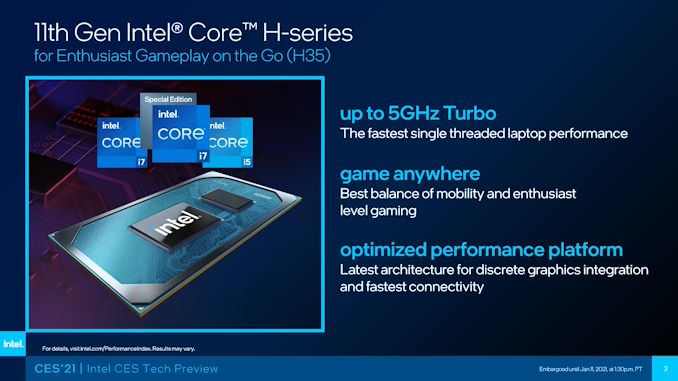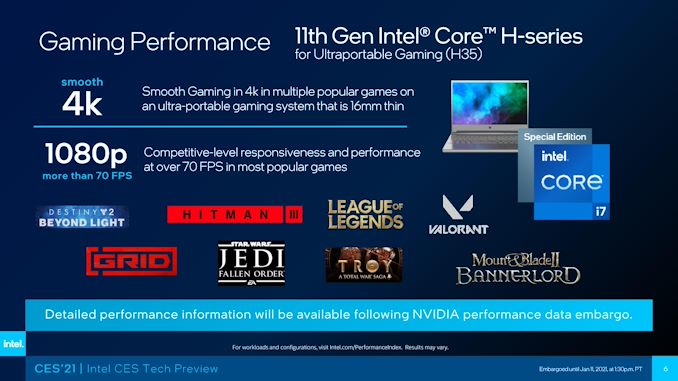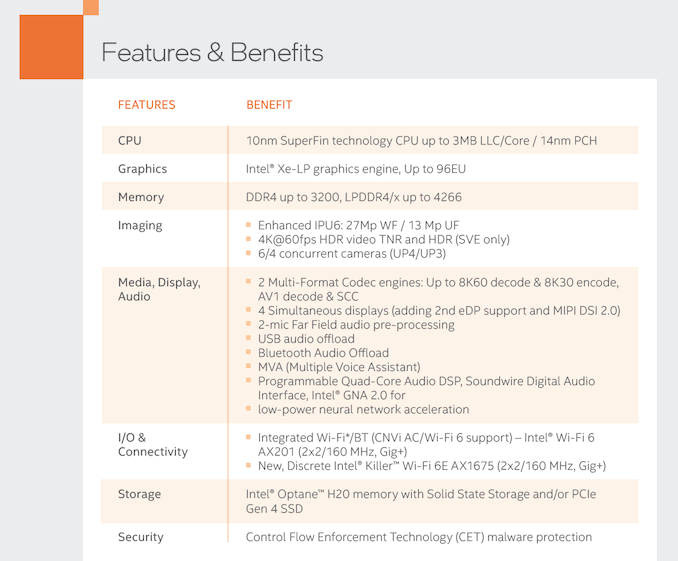Intel’s New H35 Series: Quad Core Tiger Lake now at 35 W for 5.0 GHz
by Dr. Ian Cutress on January 11, 2021 4:30 PM EST- Posted in
- CPUs
- Intel
- Mobile
- Trade Shows
- Core
- Tiger Lake
- CES 2021
- 11th Gen
- H35

Historically, both main x86 processor manufacturers have developed their mainstream mobile processors for a power target of 15 W, which in turn have been sold as their U-series chips. Above this sits the 45 W mobile processors with more cores and higher clock speeds, known as the H-series. For as much as the U-series models have been pushed up in power for more performance, to 25 W or 28 W, the H-series has sometimes pushed down to 35 W, meaning that the two never quite met in the middle. Today Intel is changing that with its first U-series processor for the 35 W mark, and with it a new processor lineup called ‘H35’.
Because this is the U-series moving up to 35 W, I’m surprised Intel called it H35, rather than U35, which would be more accurate. What Intel has done is taken its existing 11th Gen Core Tiger Lake processor, with four Willow Cove cores and Iris Xe graphics, and pushed it beyond the usual 15 W or upper 25 W power level, into the 35 W market. One of the key marketing strategies of Intel is that its processor cores are highly scalable, from mobile to server, so pushing this shouldn’t seem too much of a stretch – we already know that the 15 W model will consume 50 W or more for a brief turbo period. The question on raising the sustained power level is usually one of longevity, as well as binning and pricing.
To that end, Intel’s new H35 series will feature three variants.
| Intel Tiger Lake | ||||||||
| AnandTech | Cores Threads |
28W Base |
35W Base |
1C Turbo |
2C Turbo |
4C Turbo |
L3 Cache |
Xe GPU |
| H-Series | ||||||||
| Announced, 8C/16T, 20 PCIe 4.0. More Details Later | ||||||||
| H35 Series | ||||||||
| i7-11375H SE | 4C/8T | 3.0 | 3.3 | 5.0* | 4.8 | 4.3 | 12 MB | 96 |
| i7-11370H | 4C/8T | 3.0 | 3.3 | 4.8 | 4.8 | 4.3 | 12 MB | 96 |
| i5-11300H | 4C/8T | 2.6 | 3.1 | 4.4 | 4.4 | 4.0 | 8 MB | 96 |
| U Series (UP3) | ||||||||
| i7-1185G7 | 4C/8T | 3.0 | - | 4.8 | - | 4.3 | 12 MB | 96 |
| i7-1165G7 | 4C/8T | 2.8 | - | 4.7 | - | 4.1 | 12 MB | 96 |
| i5-1135G7 | 4C/8T | 2.4 | - | 4.2 | - | 3.8 | 8 MB | 80 |
| i3-1125G4 | 4C/8T | 2.0 | - | 3.3 | - | 3.7 | 8 MB | 48 |
| i3-1115G4 | 2C/4T | 3.0 | - | 4.1 | 4.1 | - | 6 MB | 48 |
The top model will be the Core i7-11375H Special Edition, with four cores, eight threads, and can be run in 28 W or 35 W mode – the difference being 300 MHz on the base frequency. In either mode, the system will offer a 5.0 GHz single core turbo frequency, 4.8 GHz for a dual core turbo frequency, and 4.3 GHz for an all-core turbo frequency. 5.0 GHz will only apply when the thermals are sufficiently low, which for mobile processors is typically 60ºC. This special edition also gets its own logo.
Moving down the stack, the difference between the Special Edition and the i7-11370H below it is simply that single core turbo frequency, which is only 4.8 GHz for the latter part. Meanwhile the base model is the Core i5-11300H, which still offers four cores and eight threads, but a 2.6-3.1 GHz base frequency, a 4.4 GHz two core turbo, and a 4.0 GHz all-core turbo. The stark difference here is that the L3 cache is lower, down from 12 MB to 8 MB.
All three CPUs support DDR4-3200 (64 GB) or LPDDR4X-4266 (32GB), as well as native Thunderbolt 4, and four lanes of PCIe 4.0. Intel has also enabled Resizeable BAR on its processors for NVIDIA GPUs, enabling better memory management with discrete GPUs (Intel has said that this feature will roll out to all Tiger-Lake based 11th Gen processors). Native support for Wi-Fi 6/6E as well as Intel Killer AX1675 is provided with the relevant RF module.
Intel states the goal with H35 is to enable ultraportable gaming – bundled with a discrete GPU, Intel says that H35 will enable 16mm enthusiast laptops with 14-to-15-inch screens offering smooth 4K gaming or 1080p at 70+ FPS. Intel states that they expect to have 40+ designs in the market though the first half of the year, with key OEMs on board, such as Acer, ASUS, MSI, Vaio, Dell, HP, and Lenovo.
For exact performance numbers, Intel states that the i7-11375H single threaded performance matches that of the Comet Lake i9-10980HK in SPEC2006int, and is around 6-9% faster than a standard Tiger Lake 15 W processor. Technically Intel says that these measurements were taken with the i7-11375H at 35 W and the i9-10980HK at 45 W, but as we know those TDP values are for sustained power draw, not single threaded power draw, which is likely to be under turbo.
We expect to see several laptops with Intel H35 processors inside being announced during CES 2021, which is occurring this week.
Related Reading
- Interview with Intel CEO Bob Swan
- Intel at CES 2021: Overview
- Intel at CES 2021: Press Event Live Blog
- Intel Ice Lake Xeon in Production
- Intel 11th Gen Desktop Rocket Lake Core i9-11900K ‘Preview’
- Intel 11th Gen Tiger Lake-U Boosted to 35W
- Intel 11th Gen Tiger Lake-H with 8 cores
- Intel 11th Gen Tiger Lake Goes vPro
- Intel’s Next Gen Tremont Atom in Jasper Lake for Q1




















15 Comments
View All Comments
Luminar - Monday, January 11, 2021 - link
The single and multi core throne is rightly Intel'sjospoortvliet - Monday, January 11, 2021 - link
At least in energy consumption 😂lmcd - Monday, January 11, 2021 - link
Dunno, but a fully-enabled IGP means we could see a 35W laptop with no dGPU. That'd be nice to see.Spunjji - Tuesday, January 12, 2021 - link
That already exists (pretty much):https://www.anandtech.com/show/16323/the-msi-prest...
antonkochubey - Tuesday, January 12, 2021 - link
At least until tomorrow, when AMD unveils Cezanne.Spunjji - Tuesday, January 12, 2021 - link
With a 4-core chip? Not even at 35W.neo_1221 - Monday, January 11, 2021 - link
"smooth 4K gaming or 1080p at 70+ FPS"I'd hate to see what framerate they consider "smooth".
Spunjji - Tuesday, January 12, 2021 - link
CPU performance is pretty much irrelevant to that anyway. Straws are being grasped at.trivik12 - Monday, January 11, 2021 - link
Has Intel dropped plans for Tigerlake with LPDDR5. There is no update today on that.weilin - Wednesday, February 10, 2021 - link
The issue is OEMs aren't really interested... The driver for LPDDR5 pricing is phones (even the latest iPhone 12 is still on LPDDR4). Until LPDDR5 reaches comparable pricing with LPDDR4, OEMs won't switch. Margins on PC/laptops are too thin...